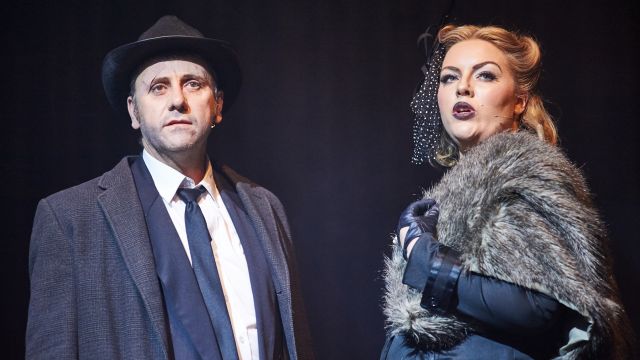City of Angels
Cy Coleman’s score for City of Angels, a fusion of Broadway and jazz, is a real treat. Splendid voices and band do great justice to the music of this rarely performed musical at Rockdale Musical Society. Very occasionally the Matthew Reid’s bold, brassy and thoroughly enjoyable orchestra overwhelms the voices, though it’s basically only an issue where music underscores spoken passages (some of it seemingly pre-recorded, and spoken too quickly).
There are many terrific characterisations too, with various cast members effectively nailing juxtaposed Hollywood studio stereotypes and detective movie character clichés.
But this little-known musical demands that contrasting design elements are also a major star, stamping their mark firmly on the production while clearly navigating the audience back and forth between the musical’s parallel plots. If I didn’t know the show so well, I’m certain I would have become confused from time to time (it’s also one of those occasions when a more detailed plot summary in the program would prove extremely helpful).
 City of Angels is a valentine to the film noir private detective genre; the complexity of its constantly intersecting dual plots and worlds demands a design which vividly switches between the real (coloured) world of a novelist Stine in the movie studio, adapting his book for a film studio, juxtaposed with the black and white screen world of the film he’s writing, featuring his alter-ego, private eye Stone.
City of Angels is a valentine to the film noir private detective genre; the complexity of its constantly intersecting dual plots and worlds demands a design which vividly switches between the real (coloured) world of a novelist Stine in the movie studio, adapting his book for a film studio, juxtaposed with the black and white screen world of the film he’s writing, featuring his alter-ego, private eye Stone.
With multi-media and LED effects so accessible and affordable nowadays (and such an obvious choice for a musical about movie-making), scenery like old-fashioned hinged stage flats, with clunky associated scene changes (also making for a very long night), seems anachronistic (where multi media can achieve instantaneous cinematic cuts and crosses, along with vivid imagery).
With several performers doubling roles across the two worlds, costuming must also consistently and clearly differentiate them.
Still, the many effective characters created by a talented cast, both the film stereotypes and real life Hollywood studio characters, goes a long way to clarifying things.
Steph McKenna delights as the sultry screen siren Alaura, in strongly established contrast to producer’s wife Carla. Rebecca MacCallion delineates starlet Avril and the film’s seductive strip-teasing Mallory very attractively. Stone’s Girl Friday Oolie and studio secretary Donna have many surface similarities, but Jacqui Greenfield distinguishes the loyal film sidekick and her manipulative studio alterego. Clare McCallum charms with her torchy blues as Bobbi in the film sequences, contrast with a more contemporary sound as writer Stine’s long-suffering wife.
Simon Ward makes film director Buddy a strong, driving force as Stine’s antagonist in the studio side of the musical, though the smaller role of mogul Irwin in the film is, as written, probably the show’s least contrasting alter ego.
 Shane William Pritchard delights the audience with his campy arrest scene as Detective Munoz, though his accent in dialogue is sometimes just a little too thick.
Shane William Pritchard delights the audience with his campy arrest scene as Detective Munoz, though his accent in dialogue is sometimes just a little too thick.
Unlike so many other characters, separate performers play writer Stine and his alter ego detective Stone. The two male leads give strong, distinct performances and anchor the show solidly. Lachlan James O’Brien establishes writer Stine clearly in the real world of the film studio in an assured performance. Clearly coming late to the role of Stine’s alter-ego screen sleuth (after the printing of the program) Craig Davidson lands the cynicism and generic vocal mannerisms of the archetypal hard-boiled film noir detective Stone effectively. There’s real dramatic tension when they eventually interact, with the boundaries between their two worlds blurring.
Slick and stylish quartet, the Angel City 4 (Chris Bamford, Rebecca Carter, Sam Hile, Annette Vitetta) chime in with impressive harmonies throughout the show, combining well with Rory Chatterton, playing crooner Jimmy Powers, very impressive regardless of the fact that he was another very late cast replacement.
Do take advantage of this all-too-rare opportunity to catch this lesser-known musical, but lacking the assistance of program notes, a pre-theatre visit to Wikipedia is highly recommended for the uninitiated.
Neil Litchfield
Photography is Chloe Snaith and Darren Purbrick.

Subscribe to our E-Newsletter, buy our latest print edition or find a Performing Arts book at Book Nook.

